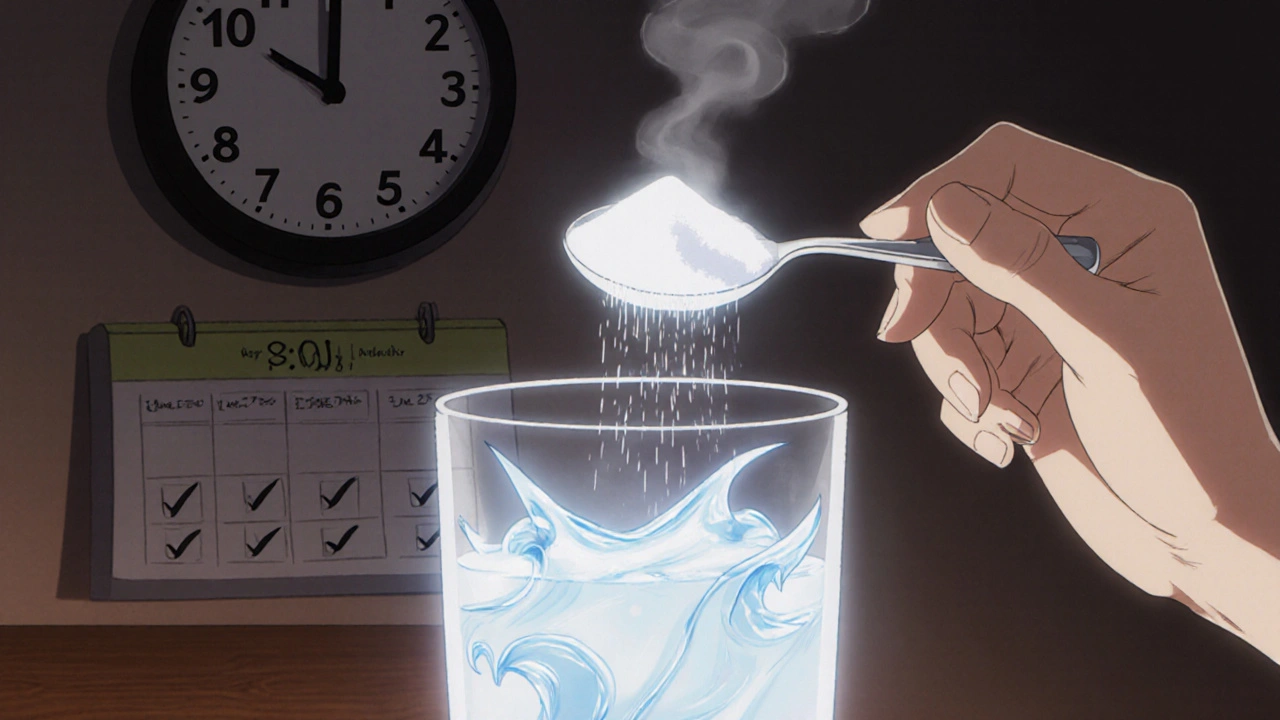Constipation isn’t just uncomfortable-it can feel like your body is stuck. If you’ve been struggling to go for days, you’ve probably scrolled through shelves at the pharmacy, wondering what actually works. You’re not alone. About 16% of adults deal with constipation regularly, and that number jumps to 33% for people over 60. The good news? You don’t always need a prescription. Over-the-counter remedies like fiber, stool softeners, and laxatives can help-but not all of them are created equal.
Fiber: The Gentle Starter
Fiber supplements like psyllium (Metamucil, Citrucel) are often the first thing people try. They work by soaking up water in your gut, turning into a soft, bulky mass that pushes things along naturally. It’s the closest thing to eating more veggies without changing your diet.But here’s the catch: fiber doesn’t work if you don’t drink enough water. If you take a psyllium pill and then don’t chug at least 8 ounces of water, you risk blocking your intestine instead of helping it. That’s not a myth-it’s a documented risk. The FDA requires this warning on every fiber supplement label.
Most people start with 5 grams a day and slowly increase to 25-30 grams over two weeks. Jumping straight to the full dose? You’ll likely end up bloated, gassy, and even more stuck. It takes 12 to 72 hours to work, so patience is key. Studies show it helps about 55% of people with chronic constipation, compared to 35% with a placebo. Not amazing, but safe for daily use.
Fiber is cheap-around $8 to $15 for a 30-day supply-and it’s the first recommendation from the American Gastroenterological Association (AGA) for anyone starting out. If fiber doesn’t help after a couple of weeks, it’s time to move to the next step.
Stool Softeners: Often Overhyped
Docusate sodium (Colace) is one of the most commonly bought OTC constipation remedies. It sounds like magic: a pill that makes stool softer so it slides out easier. But here’s the reality: it doesn’t work well on its own.Multiple clinical trials show stool softeners are only about 15-20% more effective than a placebo. That means if you’re severely constipated, Colace alone probably won’t get you there. It works in 12 to 72 hours, but it’s not a rescue remedy. You’ll see better results if you combine it with fiber or an osmotic laxative-but even then, it’s not the star of the show.
WebMD users gave Colace a 2.8 out of 5 rating, with over 60% saying it had “minimal to no effect.” Amazon reviews echo the same: “I took it for a week and nothing changed.” It’s not dangerous, but it’s not the solution most people think it is.
Doctors like Dr. Eamonn Quigley from Houston Methodist Hospital say bluntly: “Stool softeners have minimal evidence supporting their efficacy as standalone treatments.” If you’re using Colace alone, you’re probably wasting your money.
Osmotic Laxatives: The Real First-Line Choice
If fiber didn’t work and stool softeners didn’t help, polyethylene glycol (PEG)-the active ingredient in MiraLax and its generic versions-is what you should try next. This is the gold standard, backed by over 40 clinical trials involving more than 6,800 patients.PEG works by pulling water into your colon, softening stool and triggering a natural bowel movement. It doesn’t irritate your gut like stimulants do. It doesn’t rely on muscle contractions. It just gently hydrates what’s stuck.
It takes 1 to 3 days to kick in, but once it does, it works consistently. In studies, 65-75% of people with chronic constipation had relief using PEG, compared to just 35-45% on placebo. That’s a huge difference. And it’s safe for long-term use-up to six months in clinical trials-with only 15-20% reporting side effects like bloating or gas, which are usually mild.
Cost? Around $12 to $22 for a 30-day supply. Generic PEG is just as effective as MiraLax and saves you a few bucks. The AGA gives PEG a “Grade A” recommendation-the highest level of evidence. Dr. Brian Lacy from Dartmouth-Hitchcock says: “PEG should be first-line therapy for chronic constipation.”
Users on Reddit and Amazon rave about it. “Works gently without urgency,” one wrote. “No cramps. Just relief.” MiraLax has a 4.5/5 rating from nearly 30,000 reviews. That’s not luck-it’s science.

Stimulant Laxatives: Fast, But Risky
Bisacodyl (Dulcolax) and senna (Ex-Lax) are the go-to for quick relief. They work by directly stimulating your colon muscles to contract. If you need to go in 6 to 12 hours, these are your best bet.But here’s the problem: they’re not for daily use. Long-term use can lead to something called “cathartic colon”-where your colon gets so used to being prodded that it stops working on its own. The AGA warns this can happen in 15-20% of chronic users. That’s not rare. That’s a real risk.
Side effects? Abdominal cramping in 25-30% of users. Some people report intense pain and urgency. On Reddit, 65% of Dulcolax users said it “worked but with uncomfortable cramping.” Amazon reviews are mixed: 4.1/5, but plenty of comments like “felt like I was being stabbed.”
They’re cheap-$5 to $14 for 30 doses-and useful for occasional constipation, like after surgery or while traveling. But if you’re using them more than once a week, you’re setting yourself up for trouble. Dr. Satish Rao from the University of Iowa found that over half of patients misused stimulant laxatives, thinking they were safe for daily use. They’re not.
Saline Laxatives: Use With Caution
Magnesium hydroxide (Milk of Magnesia) and magnesium citrate are fast-acting. They can work in as little as 30 minutes. That’s why people turn to them for emergency relief.But here’s the danger: they pull water into your intestines so aggressively that they can cause dehydration and electrolyte imbalances. Mayo Clinic guidelines say these should only be used once or twice, never regularly. People with kidney problems or heart conditions should avoid them entirely.
Drugs.com reviews show 28% of negative experiences mention “severe diarrhea followed by dehydration.” That’s not a side effect-it’s a medical emergency waiting to happen. If you’re using Milk of Magnesia more than once a month, you need to talk to a doctor.

What Works Best? A Simple Guide
Let’s cut through the noise. Here’s what experts actually recommend, based on evidence, safety, and real-world results:
- Start with fiber (25-30g/day) + plenty of water. Give it 2 weeks.
- If fiber fails, switch to PEG (MiraLax or generic). Take 17g daily (1 capful). Works in 1-3 days. Safe for months.
- If you need fast relief (e.g., after surgery), use bisacodyl or senna-but only for 3-5 days max.
- Avoid stool softeners alone. They don’t do much.
- Avoid saline laxatives unless it’s a one-time emergency.
And here’s a pro tip: take PEG after dinner. Most people have a bowel movement the next morning. Start with half a dose if you’re new to it. Build up slowly. Drink at least 8 glasses of water a day. That’s non-negotiable.
When to See a Doctor
OTC remedies are great-but they’re not a substitute for medical care. Call your doctor if:- You haven’t had a bowel movement in 7 days despite using OTC remedies
- You’re losing weight without trying
- You have blood in your stool
- You feel nauseous, vomit, or have severe abdominal pain
- You’re using laxatives more than once a week for over a month
Constipation can be a sign of something bigger-thyroid issues, diabetes, nerve damage, or even colon cancer. Don’t ignore red flags.
The Bottom Line
You don’t need to suffer. OTC constipation remedies can help-but only if you use the right one the right way. Fiber is the safe starting point. PEG is the most effective long-term solution. Stimulant laxatives are for emergencies, not daily use. Stool softeners? Skip them unless you’re combining them with something stronger.
The market is flooded with options, but the science is clear: polyethylene glycol is the best choice for most people. It’s affordable, safe, and works. It’s not flashy. It doesn’t promise instant results. But it actually fixes the problem without breaking your body in the process.
Next time you’re at the pharmacy, skip the flashy ads. Grab the generic PEG. Drink your water. Give it a few days. You might be surprised how simple relief can be.


Comments
Kara Binning
So let me get this straight-you’re telling me I’ve been wasting money on Colace for years? My grandma swore by it, and now you’re saying it’s basically a placebo? I feel betrayed. Also, why is MiraLax so expensive when the generic works just as well? Pharmacies are robbing us blind. I’m switching to generic PEG tomorrow, and I’m telling everyone I know. This is the most honest thing I’ve read about constipation in years.
seamus moginie
Interesting article, though I must say, the emphasis on PEG is somewhat overstated. In Ireland, we’ve long relied on magnesium citrate for acute relief, and while yes, it’s potent, it’s also reliable when used responsibly. The notion that it’s ‘dangerous’ is exaggerated-unless you’re a diabetic with renal issues, it’s perfectly fine as a one-off. Also, fiber? Most people can’t even pronounce ‘psyllium,’ let alone consume 30g daily. Realistically, most folks need something faster than a week to feel better.
Michael Petesch
Can we talk about the cultural differences in constipation management? In Japan, they use a lot of fermented foods and seaweed for gut health-no pills needed. In India, triphala is a traditional remedy that’s been used for millennia. Meanwhile, here in the U.S., we’ve turned to chemical solutions because we want instant results. Maybe the real issue isn’t the laxatives-it’s our fast-paced, low-fiber, high-sugar lifestyle. We treat symptoms instead of causes.
Andrew Montandon
YES! Thank you for this! I’ve been telling my friends for years: Docusate is a scam. I took it for three weeks after surgery-nothing. Then I tried MiraLax (generic, $10 at Walmart), and poof-normal bowel movements within 48 hours. No cramps, no urgency, just… relief. Also, drink water. I know it’s annoying, but if you’re not drinking at least 8 cups a day, you’re not even trying. I’m not a doctor, but I’ve been chronically constipated since 2018, and this is the only thing that’s worked long-term. Share this with your mom.
Sam Reicks
PEG is the FDA’s secret weapon to keep us dependent on pills while they push big pharma profits. Did you know MiraLax was originally developed for veterinary use? And now it’s in every American medicine cabinet? They banned it in Canada for ‘safety concerns’-but here? We’re told it’s safe for months. Meanwhile, fiber is free and natural. Why not just eat more beans? Or better yet-stop eating processed food? This whole system is rigged. The real cure? Stop trusting corporations. Start eating real food. Or maybe you like paying $20 for a bottle of water with chemicals in it?
Chuck Coffer
So you’re telling me the only reason people use stool softeners is because they’re easy to buy and the ads say ‘gentle’? Wow. That’s not medical advice, that’s marketing. And you expect people to believe this? You’re basically saying, ‘Don’t trust your instincts, trust a 2018 clinical trial.’ Meanwhile, my cousin took MiraLax for six months and now she can’t go without it. You call that ‘safe’? I call it addiction with a prescription label.
Paige Lund
So… just drink water and take PEG? That’s it? No fancy tea? No colon cleanse? No probiotics? I’m disappointed. I thought this was gonna be a deep dive into ‘miracle’ remedies. This is just… basic. Like, I could’ve googled this.
Reema Al-Zaheri
Excellent breakdown. However, I would like to emphasize that the recommended daily intake of fiber-25–30 grams-is not achievable for many individuals without dietary changes. A single serving of oats provides 4 grams; a cup of lentils, 15.5 grams. Therefore, supplementation should be considered only after dietary optimization. Additionally, hydration must be measured in milliliters, not glasses: 2 liters minimum. Water intake below this threshold renders fiber supplementation ineffective and potentially hazardous.
Michael Salmon
Let’s be real: PEG is the pharmaceutical industry’s way of selling you a slow-acting version of a stimulant. They rebranded it as ‘gentle’ so you’d feel better about using it daily. Meanwhile, senna is demonized because it’s cheap and old. Who profits from MiraLax? The same companies that sell antidepressants, antacids, and insulin. You think this is about health? It’s about market share. The AGA? They’re funded by pharma. Read the disclosures. You’re being played.
harenee hanapi
I’ve been on PEG for 11 months now. I used to cry in the bathroom because it hurt so bad. Now I just take it after dinner and wake up feeling like a new person. But I’m so tired of people saying ‘just eat more fiber.’ I eat kale, chia, flax, prunes, apples with skin-I’m not lazy. I’m not ‘not trying.’ I have IBS-C. This isn’t about willpower. This is biology. Thank you for acknowledging that PEG isn’t a last resort-it’s a lifeline.
Christopher Robinson
Big thanks for this! I’ve been recommending MiraLax to my friends for years, but I always felt weird about it-like I was pushing a product. Now I can say: ‘Here’s the science.’ Also, if you’re new to PEG, start with half a cap. I did a full dose once and spent the next 3 hours in the bathroom like a human tornado 😅. And yes, water. Always water. I keep a 32oz bottle next to my bed now. Game changer.
James Ó Nuanáin
While I appreciate the clinical rigor of this analysis, I must take issue with the dismissal of stool softeners. In the United Kingdom, we have long prescribed docusate sodium in conjunction with opioid-induced constipation in palliative care settings. While it may lack standalone efficacy, its role in combination therapy is clinically validated and widely accepted. To label it ‘overhyped’ is to ignore nuanced medical practice. Also, MiraLax? We call it ‘Forlax’ here. And yes, it’s available on the NHS. The system works differently abroad.
Dion Hetemi
Let’s talk about the elephant in the room: nobody wants to talk about the psychological toll of chronic constipation. It’s not just physical-it’s humiliating. You avoid social events. You cancel plans. You check the clock before leaving the house. You feel like your body has betrayed you. So yeah, I’ll take a pill that works, even if it’s ‘just’ PEG. At least I can leave the house without anxiety. Stop judging people for using meds. We’re not lazy. We’re just stuck.
river weiss
One thing this article doesn’t mention: timing matters. Taking PEG in the evening aligns with your body’s natural circadian rhythm for bowel motility. Also, magnesium-rich foods (spinach, almonds, dark chocolate) can complement PEG without side effects. And for those who think fiber is ‘boring’-try adding ground flaxseed to your coffee. Tastes like nothing, works like magic. Small changes. Big results. No drama. Just science.
Brian Rono
PEG is the new Prozac for your colon-pharma’s answer to the fact that we’ve turned our guts into concrete. Meanwhile, the real solution-moving your body, eating whole foods, reducing stress-is too inconvenient for the American Dream. So we take a pill that pulls water from your kidneys to soften your poop. Brilliant. We’re not fixing the problem. We’re just making the symptoms less embarrassing. And now we’re told to take it daily for six months? That’s not treatment. That’s maintenance for a broken system. We’ve been sold a lie wrapped in clinical trials.